Unit 13- Human Body Systems Part 1
0.0(0)
0.0(0)
Card Sorting
1/101
There's no tags or description
Looks like no tags are added yet.
Study Analytics
Name | Mastery | Learn | Test | Matching | Spaced |
|---|
No study sessions yet.
102 Terms
1
New cards
What comes after Cells? (example: smooth muscle cell)
Tissues (example: smooth muscle tissue)
2
New cards
What comes after Tissues? (example: smooth muscle tissue)
Organs (example: stomach)
3
New cards
What comes after Organs? (example: stomach)
Organ systems (example: digestive system)
4
New cards
What comes after Organ systems (example: digestive system)
Organisms (example: Human)
5
New cards
Negative feedback (example: blood sugar returning to a set point after and between meals)
Counteracts change in the body that moves conditions above or below a set point
6
New cards
Positive feedback (example: child birth; torn blood vessel stimulates release of clotting factors until wound is sealed)
Increases the rate of change away from the set points
7
New cards
The purpose of the muscular system and its parts/functions
Works with skeletal muscles and the nervous to produce movement of structures or materials throughout the body.
8
New cards
Skeletal Muscle
● Muscle attaches to the skeleton by tendons.
● Tendons connect muscle to bone
● Muscles are mostly voluntary
● Tendons connect muscle to bone
● Muscles are mostly voluntary
9
New cards
Smooth Muscle
● Muscle lines organs and is involuntary.
● Moves food through digestive organs
● Empties liquid from the bladder
● Controls width of blood vessels
● Moves food through digestive organs
● Empties liquid from the bladder
● Controls width of blood vessels
10
New cards
Cardiac Muscle
● Muscle is found only in the heart.
● Pumps blood throughout body
● Under involuntary control
● Contains more mitochondria than skeletal muscle cells
● Pumps blood throughout body
● Under involuntary control
● Contains more mitochondria than skeletal muscle cells
11
New cards
One of the two main pathways the heart pumps blood through. (Having to do with the lungs)
Pulmonary
12
New cards
One of the two main pathways the heart pumps blood through. (Related to the whole system)
Systemic
13
New cards
Arteries-
● Carry blood away from the heart
● Strong and flexible
● Blood under great pressure
● Thicker, more muscular walls
● Strong and flexible
● Blood under great pressure
● Thicker, more muscular walls
14
New cards
Veins-
● Carry blood back to the heart.
● Blood under less pressure
● Thinner walls, larger diameter
● Valves prevent backflow
● Blood under less pressure
● Thinner walls, larger diameter
● Valves prevent backflow
15
New cards
Plasma
● Key factor in maintains homeostasis
● liquid portion of blood, mostly water
● Contains dissolved substances, enzymes, hormones, salts, waste products
● Plays a important role in movement of water, gasses, nutrients and ones between capillaries & cells
● liquid portion of blood, mostly water
● Contains dissolved substances, enzymes, hormones, salts, waste products
● Plays a important role in movement of water, gasses, nutrients and ones between capillaries & cells
16
New cards
Red blood cells
● Transport O2 to cells and carry away CO2
● RBC’s produced in bone marrow
● Hemoglobin in an iron-rich protein that allows more O2 to bind to each RBC
● Each hemoglobin binds with up to four O2 molecules
● RBC’s produced in bone marrow
● Hemoglobin in an iron-rich protein that allows more O2 to bind to each RBC
● Each hemoglobin binds with up to four O2 molecules
17
New cards
White blood cells
● Fight pathogens and destroy foreign matter
● Also considered part of the immune system
● Do not contain hemoglobin
● Also considered part of the immune system
● Do not contain hemoglobin
18
New cards
Platelets
● Are cell fragments that help form clots to control bleeding ● Blood clotting uses a positive feedback loop
● The body increases the rate of change until the wound is healed
● The body increases the rate of change until the wound is healed
19
New cards
Pathway of O2
Mouth &/or nose, larynx, bronchi, bronchioles, alveoli, capillary, RBC (hemoglobin), body cells
20
New cards
Pathway of CO2
Body cells, dissolves in blood, capillary, alveoli, bronchioles, bronchi, trachea, larynx, mouth and/or nose
21
New cards
Function of epiglottis
Regulates airflow into the trachea. It is a small, cartilaginous flap that closes to prevent food and liquid from going into the trachea.
22
New cards
Function of Alveoli
In the lungs are the site of gas exchange and serve to increase the surface area of the lungs so that more gas exchange can occur. A complex network of capillaries surrounds and penetrates the alveoli, allowing O2 to diffuse from an area of high concentration in the alveoli to an area of low concentration in the capillaries and CO2 to diffuse out of capillaries and into the alveoli to be exhaled.
23
New cards
Function of Diaphragm
A dome-shaped sheet of muscle that sits under the lungs. As it contracts and relaxes, the lungs expand and relax, forcing air inwards (inhalation) and outwards (exhalation).
24
New cards
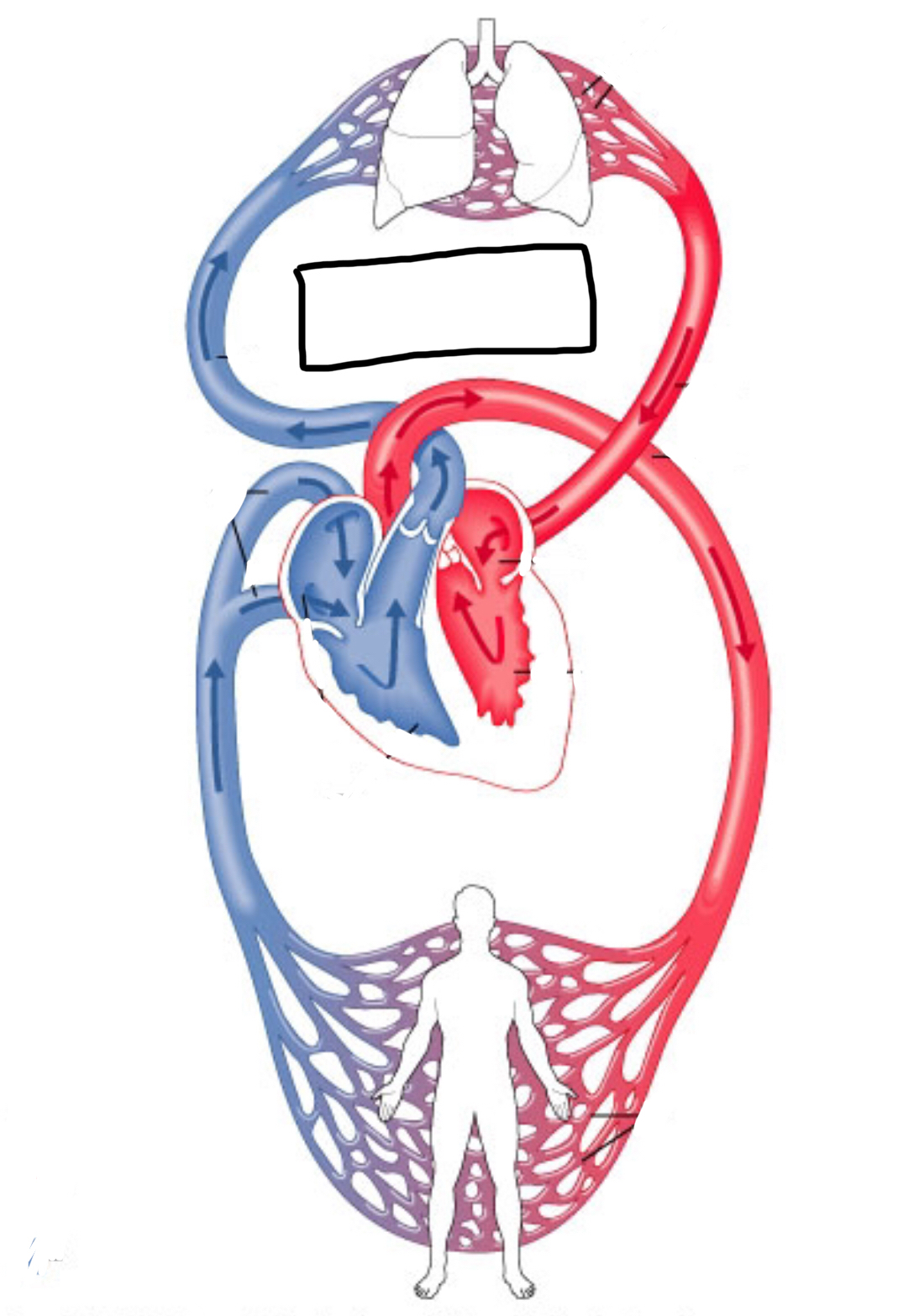
Which circulation belongs in the box?
Pulmonary
25
New cards

Which circulation belongs in the box?
Systemic
26
New cards
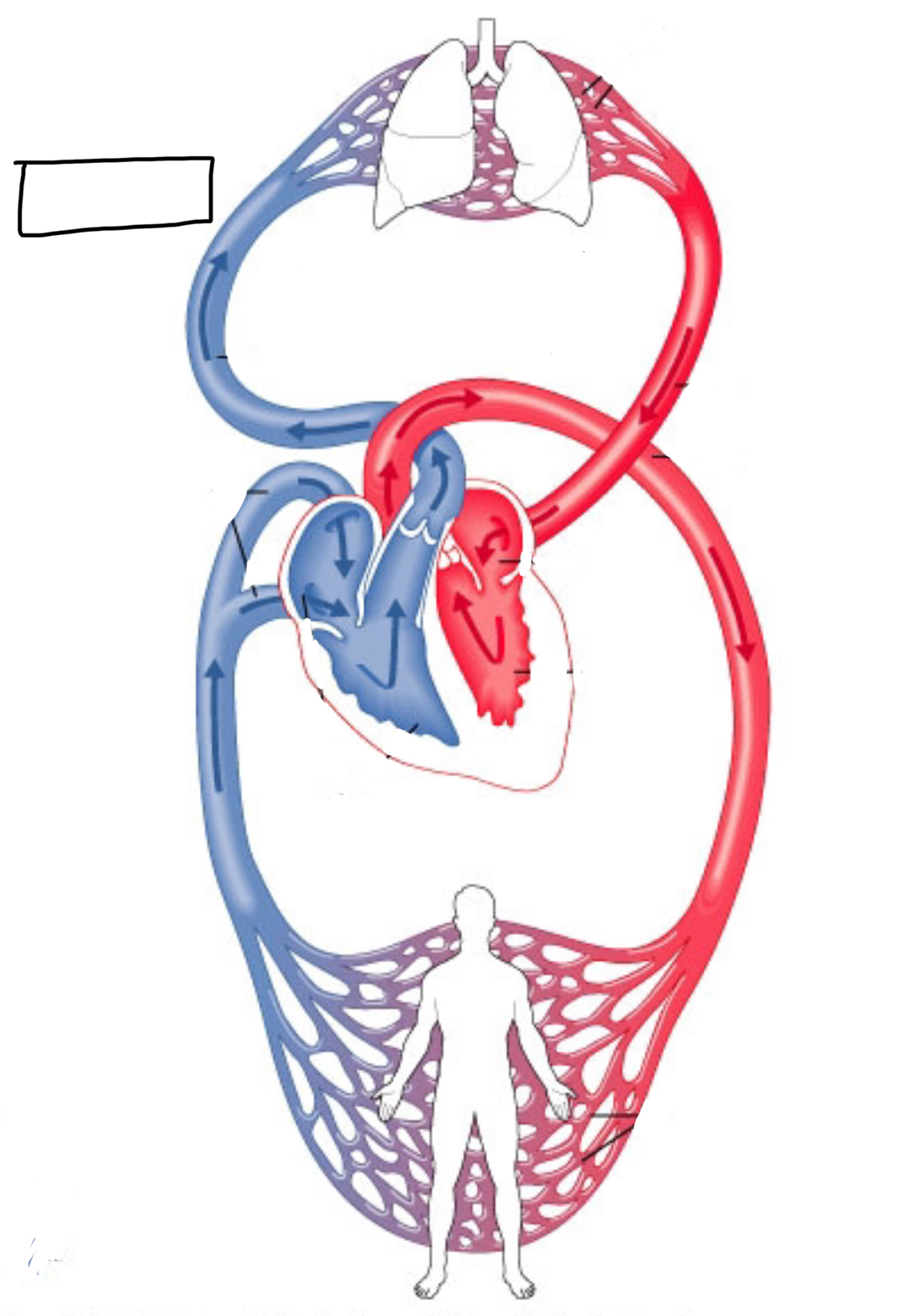
What goes in the box?
Pulmonary artery (deoxygenated blood)
27
New cards
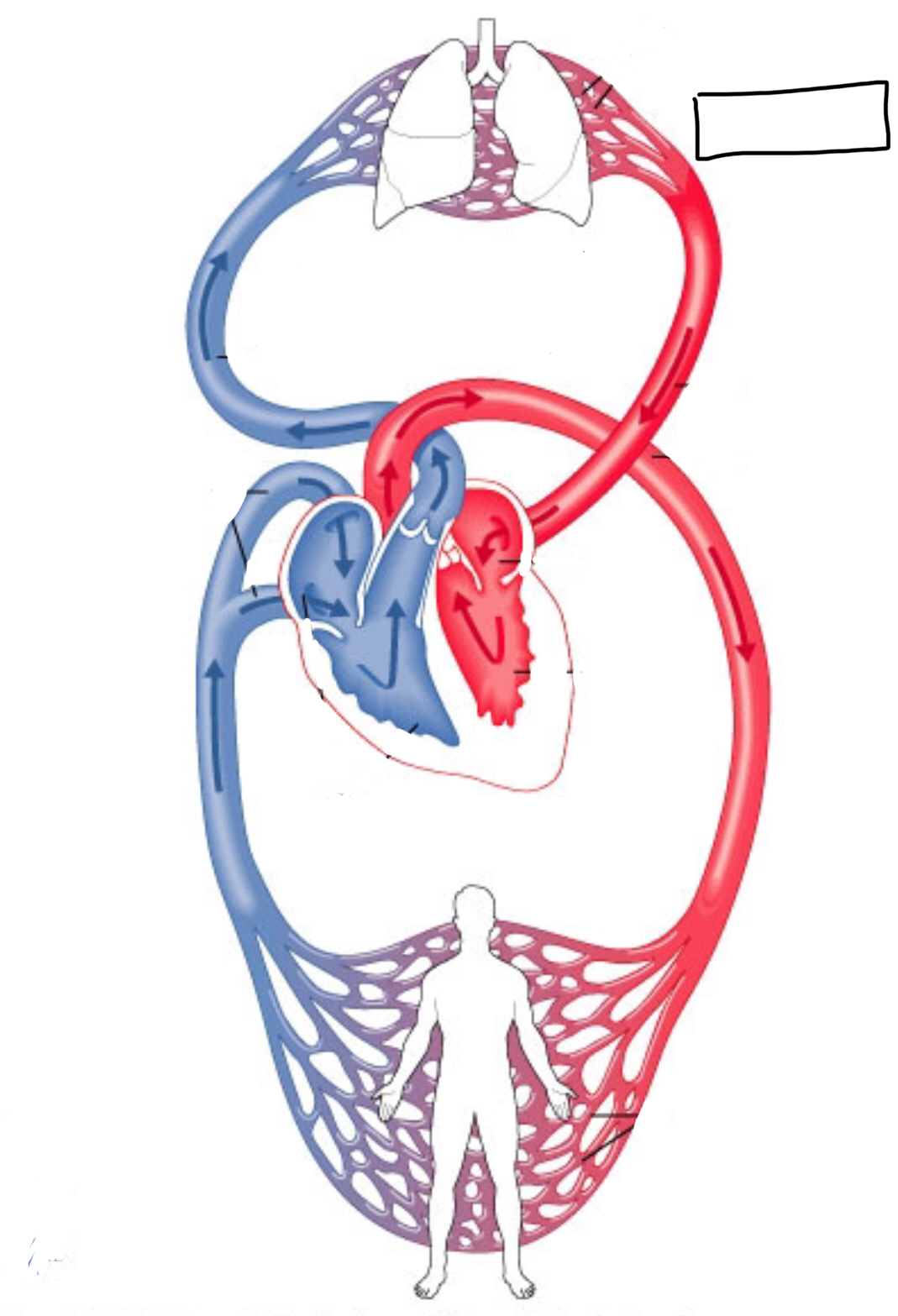
What goes in the box?
Pulmonary vein (oxygenated blood)
28
New cards
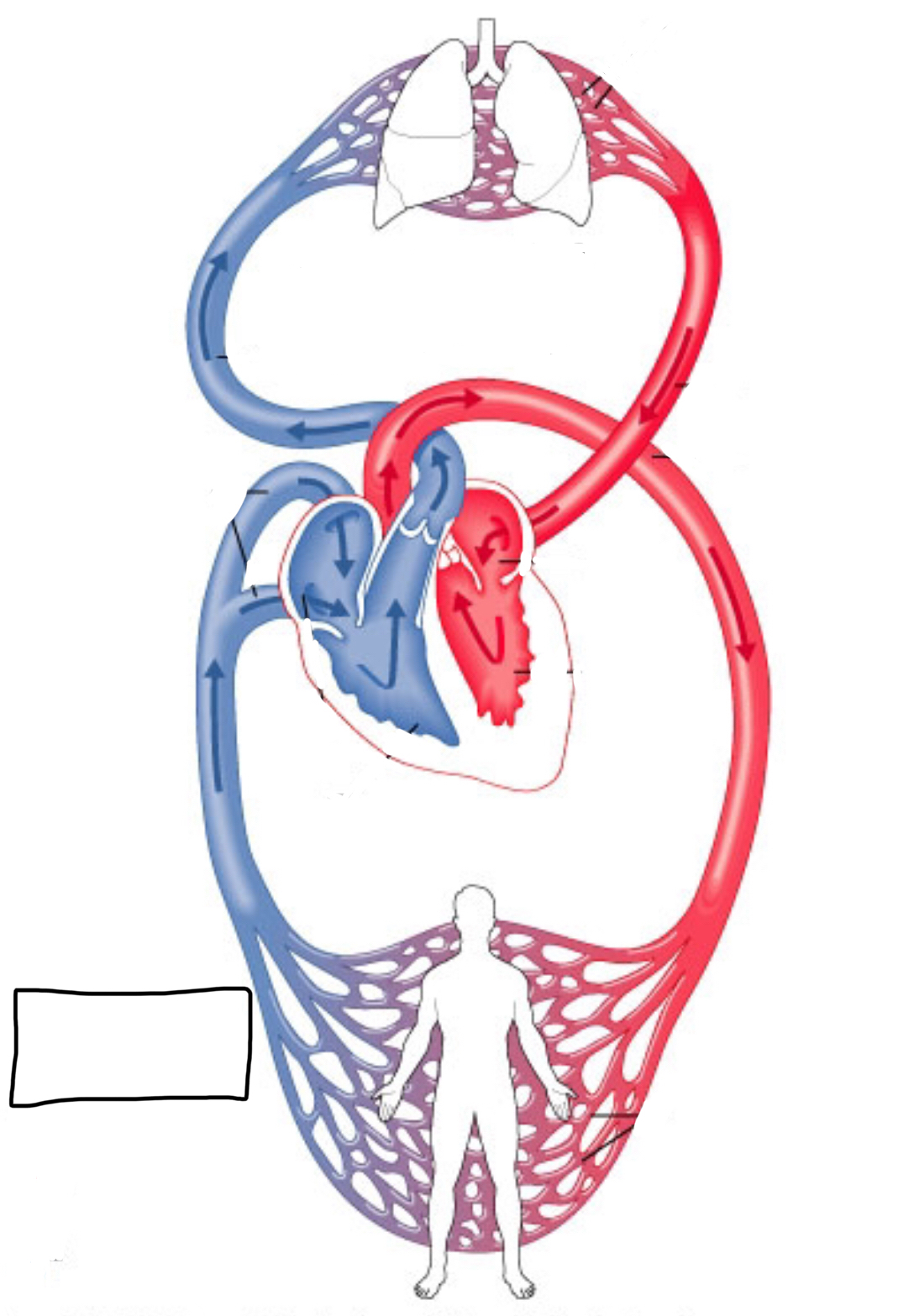
What goes in the box?
Deoxygenated blood
29
New cards

What goes in the box?
Oxygenated blood
30
New cards
Lung diseases
Reduces airflow & oxygenated absorption
31
New cards
Emphysema
Destroys alveoli
32
New cards
Asthma
Constricts airways
33
New cards
Cystic fibrosis
Produces sticky mucus in the lungs
34
New cards
Mechanical Digestion
Breaks up food by physical means, such as chewing in the mouth. This serves to increase the surface area of the food particles so that more of it can be exposed to digestive enzymes.
35
New cards
Chemical Digestion
Breaks up food by chemical means and involves the use of enzymes, such as pepsin in the stomach or amylase in the small intestine.
36
New cards
Esophagus
A muscular tube that connects the mouth to the
37
New cards
Stomach
● A muscular sac that can stretch to nearly twice its original size
● Digestions of proteins begins in the stomach (and small intestine)
● Mechanical digestion occurs as the walls of the stomach contract to mix food with gastric juices
● Chemical digests food using hydrochloric acid (HCl) and enzyme called pepsin to break down proteins
● Digestions of proteins begins in the stomach (and small intestine)
● Mechanical digestion occurs as the walls of the stomach contract to mix food with gastric juices
● Chemical digests food using hydrochloric acid (HCl) and enzyme called pepsin to break down proteins
38
New cards
Liver
● Produces bile, which is stored in the gallbladder
● Liver, gallbladder, and pancreas secrete enzymes to finish digestions of fats and proteins
● Liver, gallbladder, and pancreas secrete enzymes to finish digestions of fats and proteins
39
New cards
Gallbladder
● Liver, gallbladder, and pancreas secrete enzymes to finish digestions of fats and proteins
● Stores and releases bile which helps digest fats in the small intestine
● Stores and releases bile which helps digest fats in the small intestine
40
New cards
Pancreas
● Liver, gallbladder, and pancreas secrete enzymes to finish digestions of fats and proteins
● Aid in digestion, releases enzymes to help digest fats & proteins
● Aid in digestion, releases enzymes to help digest fats & proteins
41
New cards
Small intestine
● From stomach to small intestine where digestion is completed.
● Digestion of fats and carbohydrates occurs in the small intestine
● Most absorption occurs in small intestine
● Digestion of fats and carbohydrates occurs in the small intestine
● Most absorption occurs in small intestine
42
New cards
3 Structures in small intestine help absorb nutrients
1. Villi
2. Microvilli
3. Folded lining
43
New cards
Villi-
Also increases surface area
44
New cards
Microvilli-
Cover villi & absorb nutrients
45
New cards
Folded lining-
Adds surface area & slows food
46
New cards
Large intestine
Also known as the colon is a long tube which absorbs water and helps maintain body fluid balance
47
New cards
Rectum
Undigested material forms the solid feces and stored in the rectum
48
New cards
Anus
Undigested solid feces eliminated through anus
49
New cards
How food/nutrients go from its original form to one that can enter the bloodstream through microvilli.
Most absorption of nutrients occurs in the small intestines. Nutrients enter the circulatory system or lymphatic systems through microvilli. Nutrients are then distributed throughout the body by the circulatory system.
50
New cards
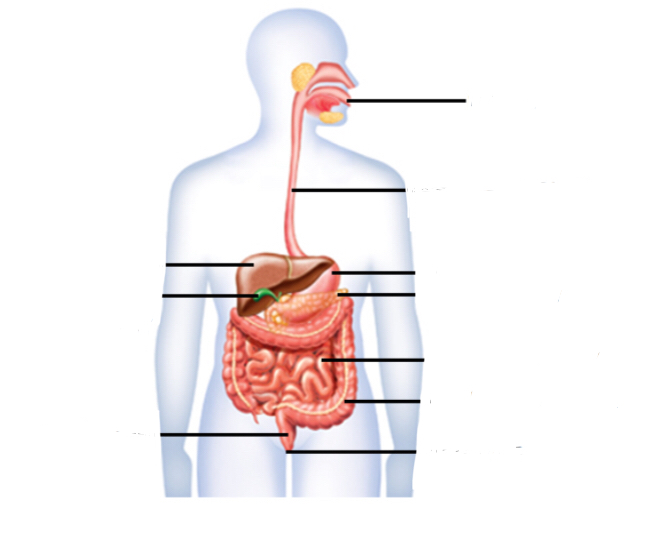
What is this component?
Mouth
51
New cards
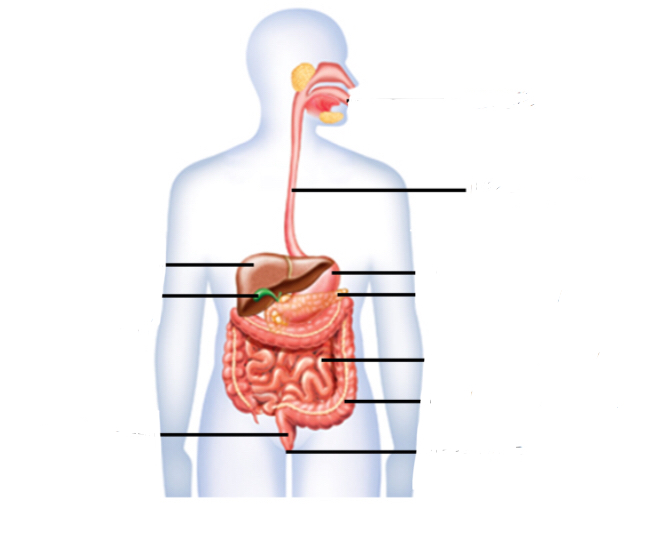
What is the component?
Esophagus
52
New cards
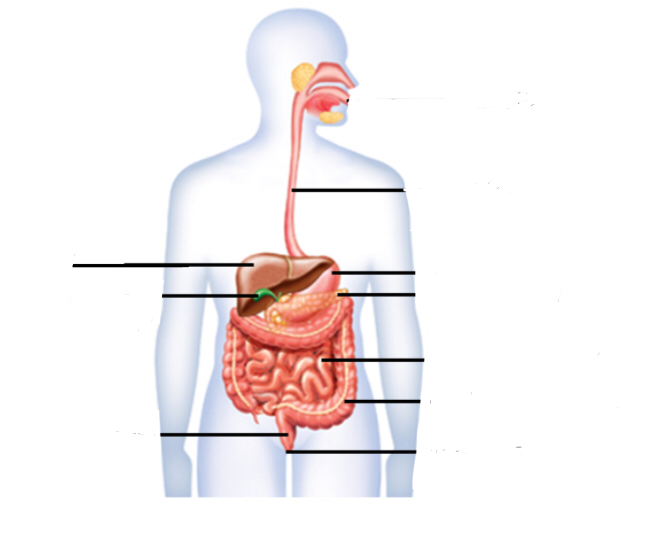
What is the component?
Liver
53
New cards
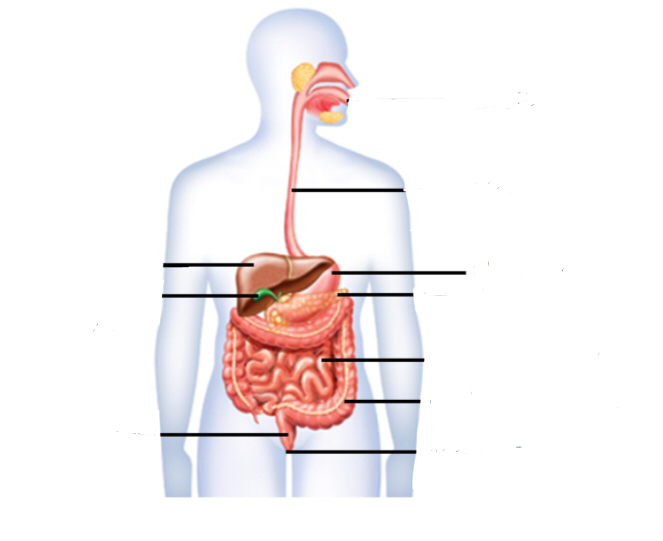
What is the component?
Stomach
54
New cards
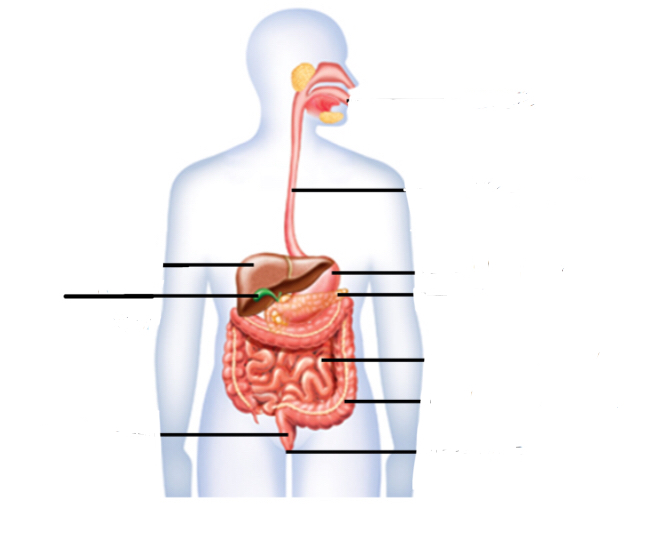
What is the component?
Gallbladder
55
New cards
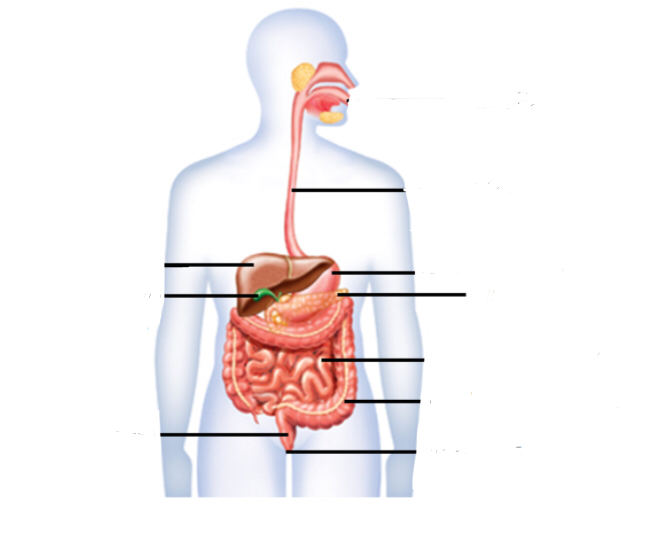
What is the component?
Pancreas
56
New cards
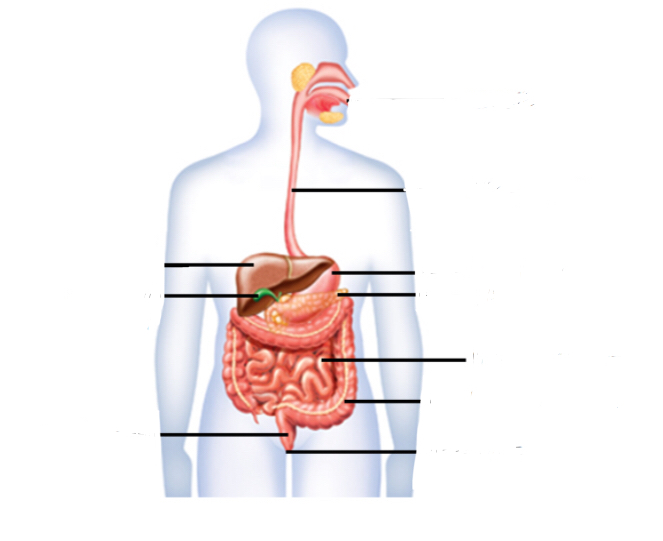
What is the component?
Small intestine
57
New cards
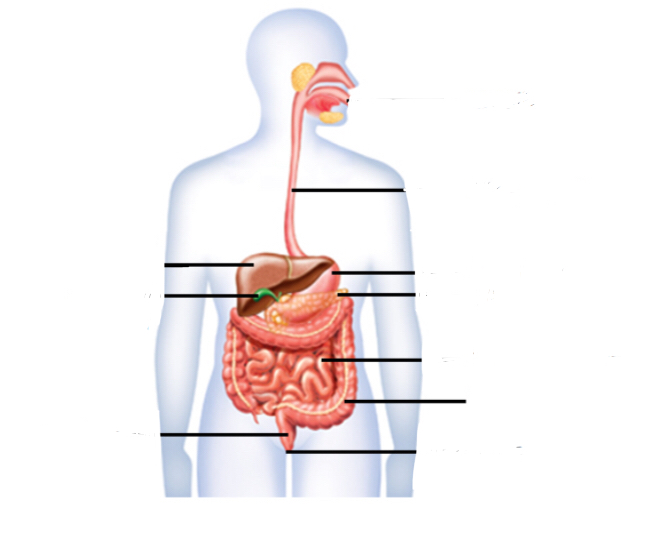
What is the component?
Large intestine
58
New cards

What is the component?
Rectum
59
New cards
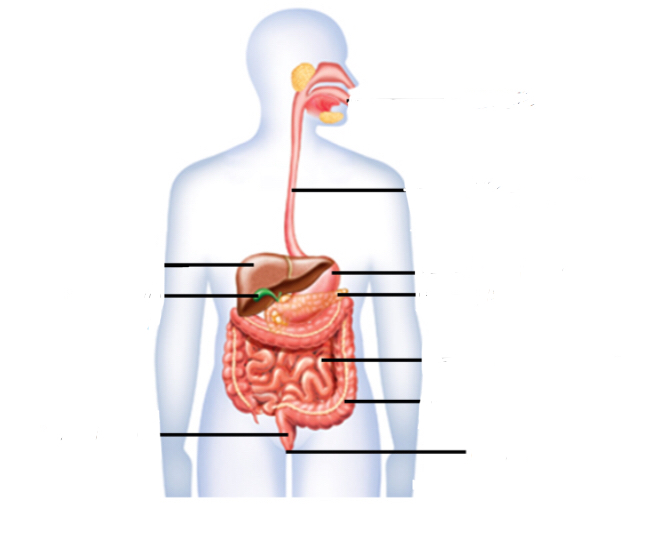
What is the component?
Anus
60
New cards
Peristalsis
The rhythmic, involuntary contraction of the smooth muscles in the walls of digestive organs, which helps to move food through the organs.
61
New cards
Sphincter
A ring of muscle that separates the areas of the digestive system. It can open and close to keep food moving in one direction.
62
New cards
Give an example of a sphincter in the body
Anal sphincter, esophageal sphincter (between esophagus and stomach), pyloric sphincter (between stomach and small intestine)
63
New cards
Carbohydrates
Begins in the mouth by the enzyme salivary amylase, continues in small intestine by amylase
64
New cards
Proteins
Main site is stomach ; the enzyme pepsin along with hydrochloric acid (HCl) break down proteins into amino acids, which get absorbed in the small intestine
65
New cards
Lipids
Main site is small intestine; bile (made in liver, stored in gallbladder) is released into the small intestine, which emulsifies the fat (breaks it into small droplets), which is then absorbed through the small intestine
66
New cards
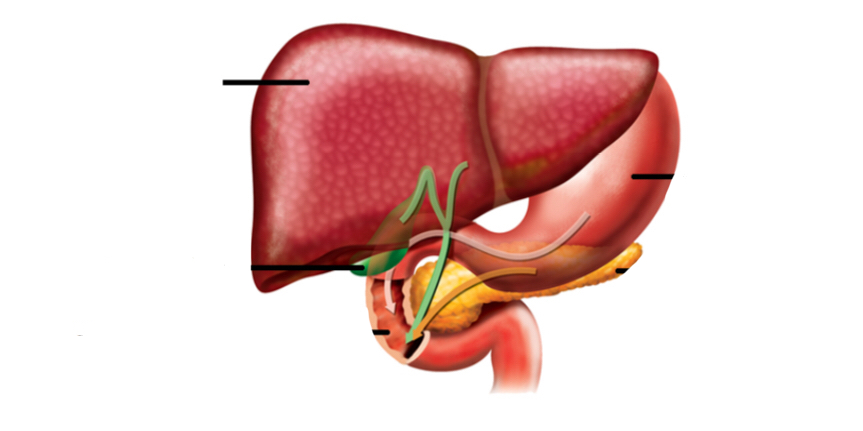
Label the structures
Liver
67
New cards
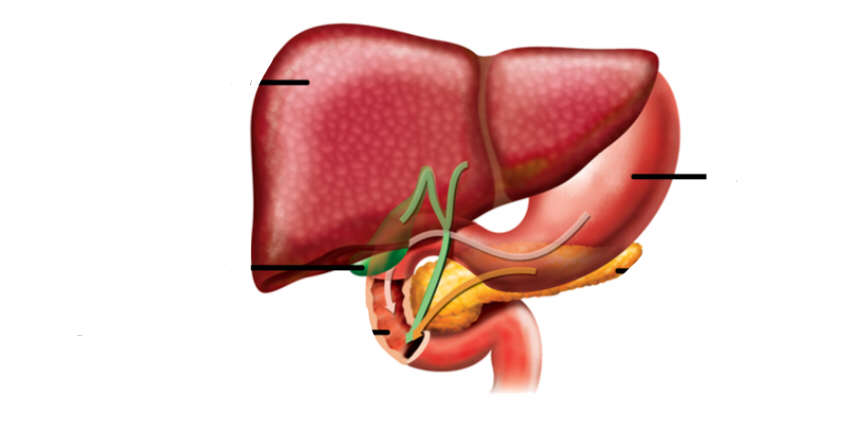
Label the structure
Stomach
68
New cards
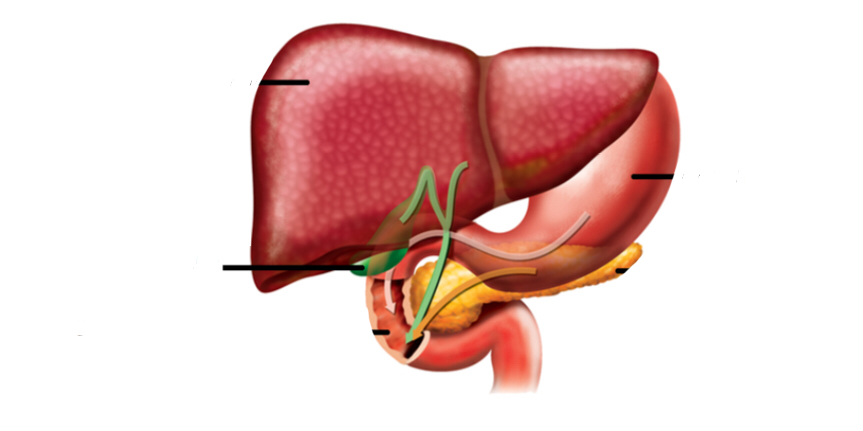
Label the structure
Gallbladder
69
New cards
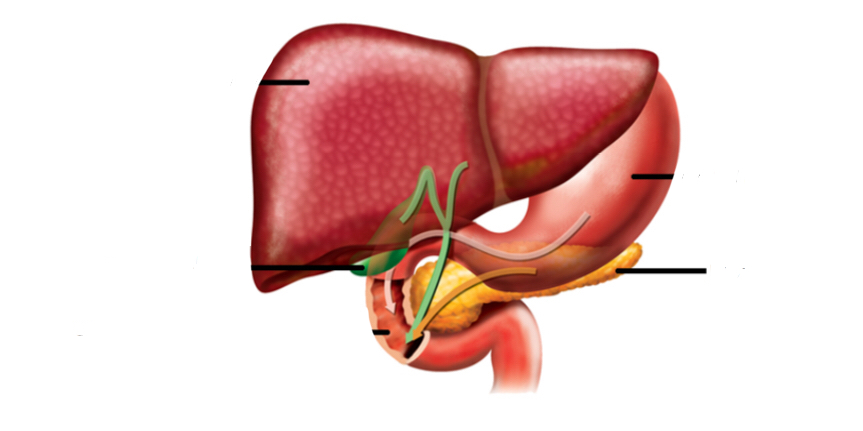
Label the structure
Pancreas
70
New cards
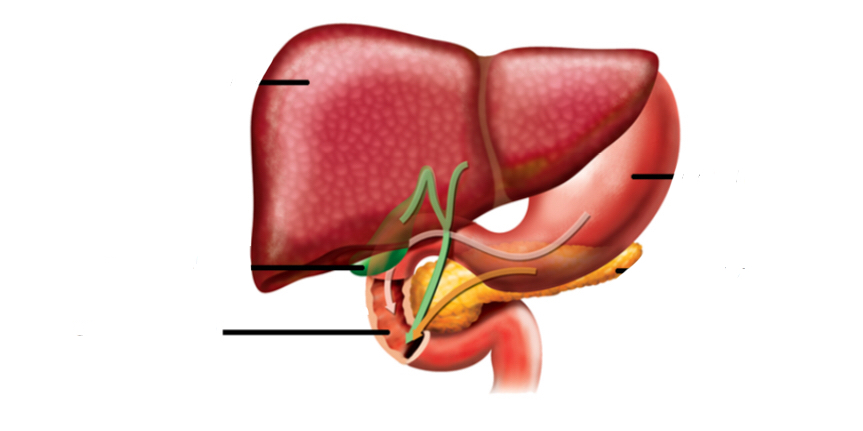
Label the structure
Small intestine
71
New cards
Function of the Liver in digestion
Produces bile that helps to digest fats
72
New cards
Function of the gallbladder in digestion
Stores bile to be released into the small intestine
73
New cards
Function of the pancreas in digestion
• Releases an alkaline fluid to help neutralize the acid and stop the action of pepsin
• Also releases enzymes to break down starches into simple sugars
• Also releases enzymes to break down starches into simple sugars
74
New cards
Function of bile
Breaks down large fat globules into smaller droplets
75
New cards
Small intestine (descriptive)
The small intestine is the site of nutrient absorption. The complex molecules of carbohydrates, proteins, and fats that were broken down in digestion are absorbed into the bloodstream to be delivered to cells through the cells of the small intestine.
76
New cards
Large intestine (descriptive)
The large intestine (colon) is a long tube which helps maintain the body’s fluid balance. Undigested material forms the solid feces, which are stored in rectum, and eliminated through the anus. The small intestine is longer and more narrow while the large intestine is shorter but wider in diameter.
77
New cards
How food goes from its original form to nutrients that can enter the bloodstream. Identify what structures in the small intestine assist in nutrient absorption.
Food is digested in the mouth, stomach, and first part of the small intestine into smaller components, such as simple sugars and amino acids. These smaller molecules are absorbed into the bloodstream through the walls of the small intestine. The lining of the small intestine consists of folds to help increase surface area. These folds are covered in small extensions called villi, which are covered in even smaller extensions called microvilli. Nutrients enter the circulatory or lymphatic systems through microvilli. Nutrients are then distributed throughout the body.
78
New cards
Purpose of the excretory system/urinary system
To remove the body of waste.
79
New cards
Kidneys-
Filter and clean the blood (waste out of the blood) to produce urine; a pair of bean shaped organs.
80
New cards
Renal artery & renal vein
Transport blood to from the kidneys
81
New cards
Renal
Means related to kidneys
82
New cards
83
New cards
84
New cards
85
New cards
Ureter
Transports waste to urinary bladder
86
New cards
3 basic functions of maintaining homeostasis
● Remove waste from blood
● Help maintain electrolyte balance, pH and fluid balance
● Release key hormones
● Help maintain electrolyte balance, pH and fluid balance
● Release key hormones
87
New cards
Bladder
Stores the urine before removal
88
New cards
Urethra
Where urine leaves the body
89
New cards
Liver
Removes toxins & drugs, detoxifies the body
90
New cards
Skin
Sweat glands removes excess salts & toxins from the blood
91
New cards
Lungs
Removes carbon dioxide & water from the body
92
New cards
Function of the excretory system
Nonsolid wastes are eliminated through an excretory system. Waste products include toxic materials, excess water, salts, CO2, urea (in the form of urine), minerals, and vitamins.
93
New cards

Label the excretory system structures
Skin
94
New cards

Label the excretory system structures
Skin
95
New cards
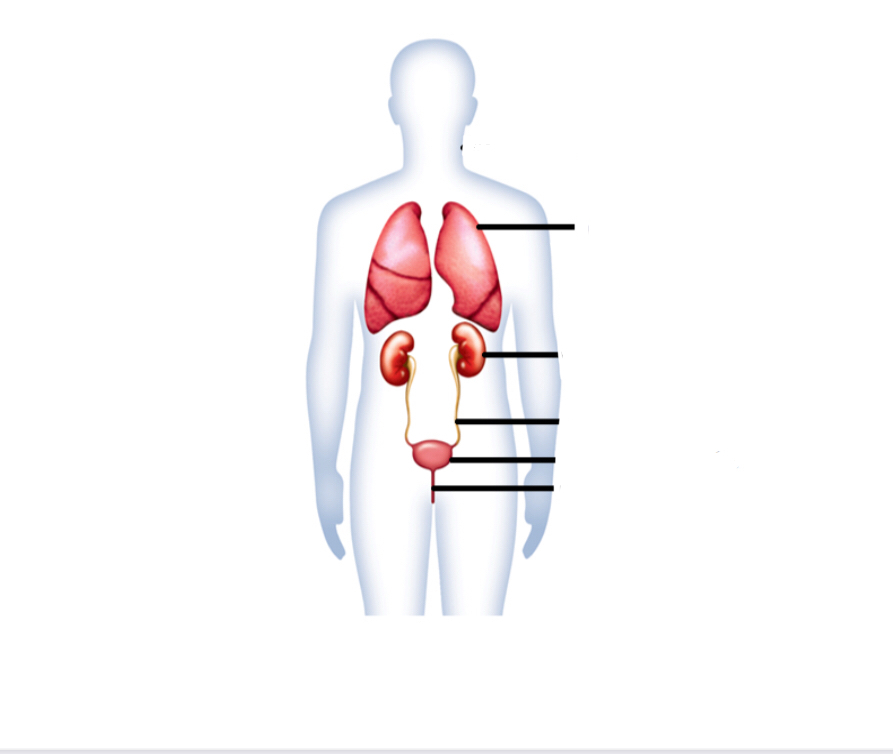
Label the excretory system structures
Lung
96
New cards

Label the excretory system structures
Kidney
97
New cards

Label the excretory system structures
Ureter
98
New cards
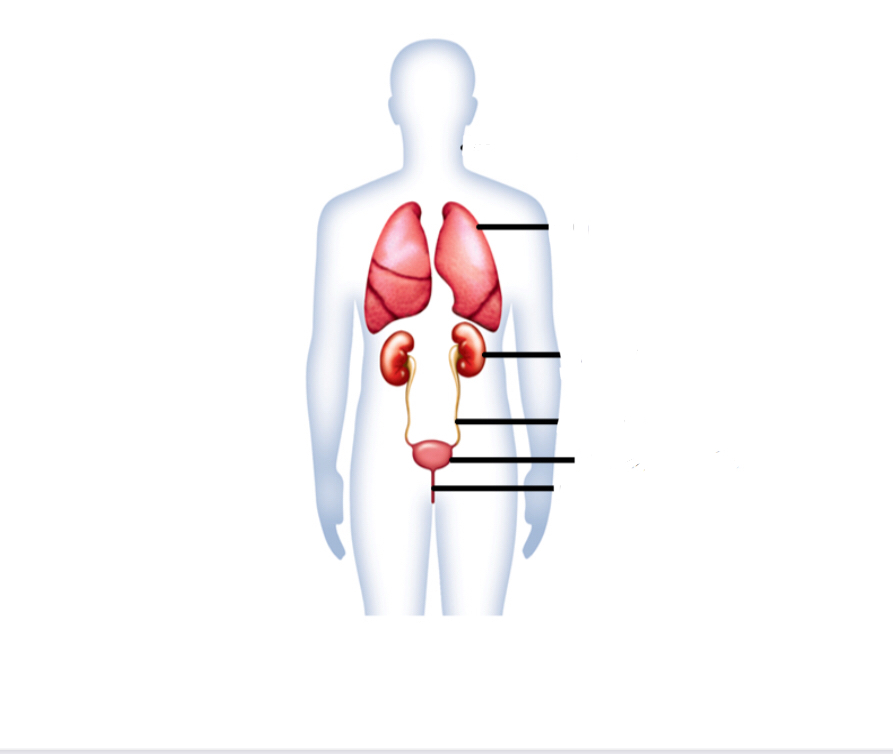
Label the excretory system structures
Urinary bladder
99
New cards
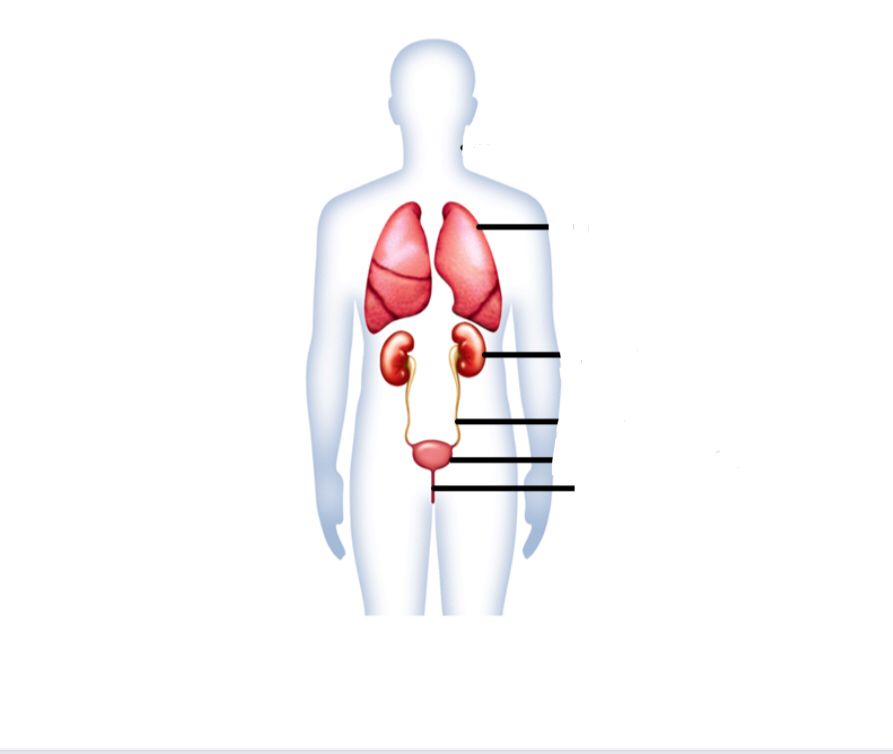
Label the excretory system
Urethra
100
New cards
Function unit of the kidney
○ Nephron
○ Filters blood to remove waste
○ Reabsorbs excess water back into the blood
○ Filters blood to remove waste
○ Reabsorbs excess water back into the blood